

Adding Extensions to SketchUp. The Extension Warehouse and SketchUp were made to work together.

In most cases, to add an extension on your local copy of SketchUp, you simply click the Install button on the extension details page and wait a moment while the software does the rest of the work. However, this magical installation process comes with a few caveats: You must access the Extension Warehouse from SketchUp (as opposed to a browser).
If you access the Extension Warehouse from a web browser, you see a Download button instead of an Install button, and you then need to install the downloaded .rbz file manually through SketchUp Preferences.Tip: Installing and managing extensions is easiest if you access the Extension Warehouse from SketchUp by selecting Window > Extension Warehouse.The extension is a free extension. Many extensions on the Extension Warehouse are free for you to download and use. Installing extensions manually in SketchUp Preferences.
Stormwater Policy. Stormwater News & Events. Zero Net Water. For Educators. WA State Department of Ecology - Resources & Trainings. Puget Sound Partnership. Stewardship Partners & 12,000 Rain Gardens. Loving the Puget Sound to Death. (Illustration by Tim Robinson) This article was reported with support from the National Health Journalism Fellowship, a program of the USC Annenberg School for Communication and Journalism.
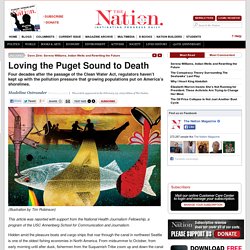
Hidden amid the pleasure boats and cargo ships that roar through the canal in northwest Seattle is one of the oldest fishing economies in North America. From midsummer to October, from early morning until after dusk, fishermen from the Suquamish Tribe zoom up and down the canal in orange waterproof overalls, tending to salmon nets that dangle across the water like strings of pearls. The tribe holds reservation land about ten miles west of the city, on the far side of Puget Sound, the 100-mile-long estuary that extends from Olympia, Washington, north to the Strait of Juan de Fuca. The men unload salmon at “A Dock,” a section of a boatyard reserved for tribal fishing boats. Ringed by the white-capped Cascade and Olympic Mountains, Puget Sound looks pristine. Please support our journalism. Code Innovations: Site and Stormwater. The Russell Family Foundation Stormwater Report.
Report: Puget Sound Stormwater, The Russell Family Foundation. Toward a sum greater than its parts.
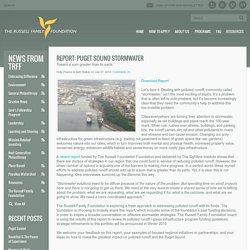
Let’s face it: Dealing with polluted runoff, commonly called “stormwater,” isn’t the most exciting of topics. It’s a problem that is often left to policymakers, but it’s become increasingly clear that they need the community’s help to address this too-invisible problem. Cities everywhere are turning their attention to stormwater, especially as old buildings and pipes reach the 100-year mark. When rain rushes over streets, buildings, and parking lots, the runoff carries dirt, oil and other pollutants to rivers and streams and can cause erosion. Changing out gray infrastructure for green infrastructure (e.g. trading out pavement in favor of green space like rain gardens) welcomes nature into our cities, which in turn improves both mental and physical health, increases property value, conserves energy, enhances wildlife habitat and saves money on more costly pipe infrastructure.
Portable Bio Retention Planters at Port of Seattle — Northwest EcoBuilding Guild. Abstract The "Moving Green Infrastructure Forward" Project is a two-year stormwater monitoring project at Terminal 91, Port of Seattle.
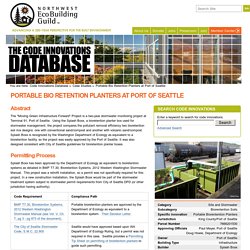
Using the Splash Boxx, a bioretention planter box used for stormwater management, the project compares the pollutant removal efficiency two bioretention soil mix designs: one with conventional sand/compost and another with volcanic sand/compost. Splash Boxx is recognized by the Washington Department of Ecology as equivalent to a bioretention facility, so the project was easily approved by the Port of Seattle. It was also designed consistent with City of Seattle guidelines for bioretention planter boxes. Permitting Process Splash Boxx has been approved by the Department of Ecology as equivalent to bioretention systems as detailed in BMP T7.30, Bioretention Systems, 2012 Western Washington Stormwater Manual.
Floodplains by Design. Stack House Apartments Swale on Yale (Bioswale) Video of stormwater pollution in Puget Sound. Top 10 things that reduce stormwater runoff. Maintain your car or truck.
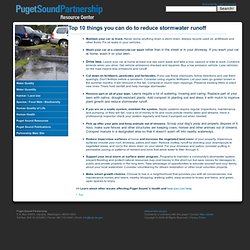
Never dump anything down a storm drain. Always recycle used oil, antifreeze and other fluids. Fix oil leaks in your vehicles. Wash your car at a commercial car wash rather than in the street or in your driveway. If you wash your car at home, wash it on your lawn. Urban Waters - EPA. Encyclopedia of Puget Sound. Stormwater videos. Stormwater Services and Information. Report a drainage or water quality problem The Stormwater Services Section investigates more than 600 drainage and water quality complaints annually.
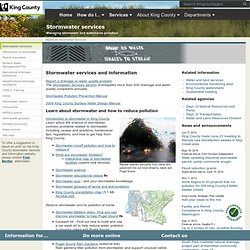
Stormwater Pollution Prevention Manual 2009 King County Surface Water Design Manual Learn about stormwater and how to reduce pollution Rainfall washes pollutants from yards and pavement into our local streams, lakes and Puget Sound. Introduction to stormwater in King County Learn about the science of stormwater, common problems related to stormwater including causes and solutions, homeowner tips, regulations, and how to get help from King County. Reduce stormwater and its pollution at home Act to reduce local flooding Clear storm drains, reduce local flooding - 15-sec video (WMV) or 30-sec audio (MP3) Join Take Winter by Storm on Facebook (external link) Drainage design resources for professionals.
Protecting Washington’s waters from stormwater pollution.